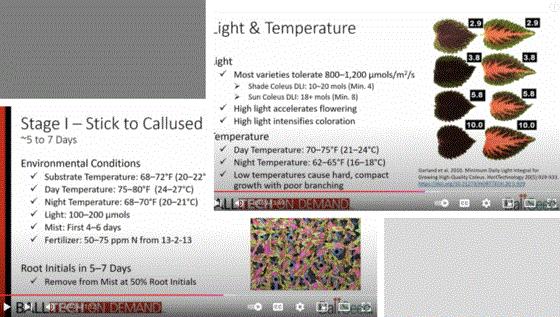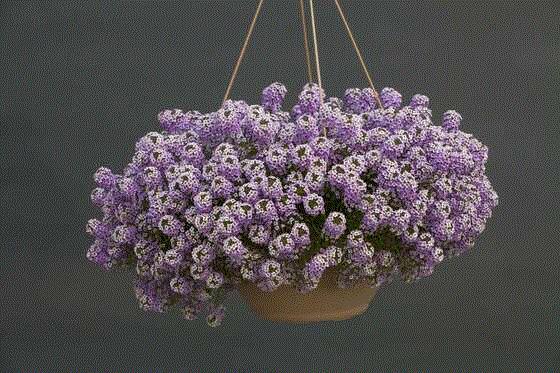VIDEO BOX SET! Propagating & Finishing Vegetative Coleus
One of my Tech On Demand goals for the second half of 2024 and throughout 2025 is to release a huge series of crop-specific content with an emphasis on finishing best practices. So far, we’ve produced videos and podcasts on seed begonia, seed coleus, seed anemone, seed lisianthus, vegetative cut flower dahlia, pansy and Sunfinity sunflowers.
That’s a good start, but we have many more on the list—including a bunch of the top vegetatively-produced species. This week, I posted an awesome two-parter on vegetative coleus presented by Ball Technical Services specialist Josh Henry. The first part covered propagation, and the second part focused on finishing.

In VEGETATIVE COLEUS PROPAGATION BMPs, Josh takes you from prioritizing and receiving/handling through all stages up to transplant. He covered environmental requirements, nutrition, pest and disease control and much more. It’s concise and to-the-point but covers a lot of ground.
In FINISHING AMAZING VEGETATIVE COLEUS, he takes the crop from transplant to ship with a focus on water management, weeks required to finish in different container sizes and lighting protocols for sun- and shade-loving varieties, and then he spends time on strategies to prevent coleus downy mildew.
As we’ve done with the rest of the series, these conversations are also available as podcasts for those of you who like to take them on the go. Be sure to subscribe to the Tech On Demand podcast on your favorite app so you never miss an episode. And this winter, why not jump back into the archives and get caught up—there are more than 145 episodes as of today!

Nick’s Tip of the Week: Planning Ahead to Avoid Phyto
Each week, I’ll work with my buddy Nick Flax, a technical services expert at Ball, to share a concern that’s come up during one of his numerous calls with growers across North America. This week, he wants to discuss a common challenge you all face from time to time: phytotoxicity.
PROBLEM: Think ahead to next spring when your greenhouse is packed to the gills and finished material is really starting to ship … it will be really tough to keep track of the small things. What got sprayed and what didn’t? Which fungicide did I use? What rate did I use? These are all questions that might run through your head when you spot odd symptoms appearing in your crop.

NICK’S TIP: Let’s review a few common causes of phytotoxicity that occur in North American spring crops and how to avoid these issues when your greenhouses are full in a few short months.
Note: I will mention some specific chemistries in this week’s tip, but these are not meant to be criticisms of the products mentioned. In fact, it is my hope that specific mentions here will help build awareness of common errors made with these products out in the greenhouse and help you all to be more successful with them in the future.
Fungicide Phyto
One of the harder-hitting fungicides in the bedding plant grower toolbox is fludioxonil, more commonly known and sold as Medallion (a FRAC 12 fungicide). This is one of my go-to fungicides for managing pathogens like Fusarium and Rhizoctonia, but it also has broader use in combating Botrytis and several fungal leaf spot pathogens. However, there are a couple of crops that Medallion should never be applied to, and the label specifically cautions applicators against doing so: namely geraniums (any Pelargonium spp.) and New Guinea impatiens. Stunting, chlorosis and/or distortion are typical symptoms that result when applied to these two crops, and the only real path forward is to push through the stunting and flush new growth out over the damaged foliage.
-
Most often when this occurs, the grower/applicator needed to make a quick decision on which fungicide to apply and forgot the cautionary statement on the label. While you should always thoroughly review the label of any IPM product before using it, glossing over the footnote about potential phyto is an understandable oversight.
-
If you aren’t sure if a fungicide can be safely applied to a given crop and you can’t read the fine print on the label attached to the bottle, run a quick check on the digital label. Visit the product manufacturer’s website, find the most up-to-date version of the product’s label, and open it as a PDF. Then, hit Control + F (or Command + F for Mac users) and type the common name of the crop in question and again using the Latin name, if you know it. If there are any cautionary statements regarding the crop in question, the search function will take you right to it, rather than searching line by line or potentially missing it all together.
-
While it may seem painfully simple, write “DO NOT apply to X, Y, or Z crop” on the side of the container with an industrial Sharpie for Medallion or other fungicides with similar phyto concerns on specific crops. This way, every time you take this fungicide out, there’s a highly visible reminder to avoid applying it to the wrong crops. Just be sure to rewrite the note if the marker starts to smudge or fade.
Insecticide/Miticide Phyto
Much like the crop-specific phyto concerns of Medallion, insecticide/miticide products can pose similar risks.
-
Misapplication of spirotetramat (commonly sold as Kontos here in the US) is a frequent cause behind distortion, stunting and chlorosis on finished geraniums this time each year.
-
Kontos is a staple in many growers’ IPM toolboxes—especially for managing two-spotted spider mites and broad mites—but this one should be left out of the rotation on your geraniums and a few other tropicals/foliage plants (see the label for more details).
While the phytotoxicity that can result when this product is applied to geraniums looks concerning, most mature crops can push through the damage and recover within a couple of weeks. Higher dosage earlier in the crop cycle can have longer-term impact and delay time to finish, but Kontos phyto most often occurs as a later-season “oops” in the spray program. Be sure to add a “NOT for geraniums” note to the bottle for this one, as well.
The moral of the story here is this: Always read the label and take a couple of extra minutes to make sure your IPM product is safe to apply to your target crop. It’s easy to get caught up in the hectic pace of spring and grab the first thing on your chemical storage shelf, but an accidental misapplication could be the difference between getting a premium for your plants and getting them to retail a week or two late.

From Facebook: I Need Lobularia Advice!
This week, a question was posted to the Greenhouse Tech Team Facebook Group and I thought it would be a good one to include (with the answer) in this newsletter. Reminder: If you’re not a member of the group, now’s the time to join more than 6,000 of your peers in a closed group for greenhouse professionals. Once you answer a couple simple questions (to prove you’re a pro and not a hobbyist) I’ll be more than happy to let you in.
Here's the question that came in from a grower in the U.S. Southeast:
I have a contract grow for lobularia for next year. It's been a long time since I've grown it. Can anyone refresh my memory on the best NPK water soluble fertilizer to use through an injector and best NPK slow-release fertilizer? Also, will B-Nine be sufficient as a growth regulator? I'll be growing Snow Princess, Blushing Princess and Purple Stream Compact.

I reached out to the Tech On Demand team for advice, and here’s what they had to say:
Lobularia can be successfully grown with a wide range of commercially available fertilizers. When selecting a fertilizer, it is more important to consider your irrigation water quality, specifically your alkalinity. If you have high alkalinity and are not injecting acid, it would likely be best to select a more neutral (17-5-17 for example) to acidic (like 20-10-20) fertilizer.
If alkalinity is low or acid is being used, you can use a more neutral (such as 17-5-17) to basic (13-2-13) fertilizer. These commercial fertilizers can all be used to grow a successful crop as long as substrate pH is around 6.0 and the EC is around 0.8 to 1.0 mS/cm via the 1:2 Dilution method. Note that more acidic fertilizers like 20-10-20 also have higher levels of ammonium or urea nitrogen, which can cause stem stretch and generally soft growth. Water-soluble fertilizers would be better to use than controlled-release fertilizers, especially if plants are being grown cool, because controlled release fertilizers do not work well at lower temperatures. Water-soluble fertilizer rates should be around 150 to 200 ppm N for Snow Princess and Blushing Princess but a bit lower for Stream—around 100 to 150 ppm N.
Growing at cooler temperatures, especially when using DIF or DROP, can yield naturally compact growth. Daminozide (B-Nine) sprays are recommended for Stream lobularia, but the culture guides for Snow Princess and Blushing Princess recommend uniconazole (Sumagic) sprayed at 5 ppm, flurprimidol (Topflor) sprayed at 10 ppm or paclobutrazol (Bonzi) drenched at 1 to 2 ppm, especially later in production to hold.

NEW VIDEO: Poinsettia Trials & Why We Like the Crop
In her May 2024 column, GrowerTalks editor Jen Zurko asked the question, “Do we still like poinsettias?” After talking to a handful of experts with many years’ experience growing and selling the holiday crop, she determined there are three primary reasons many growers “have to” produce them. 1) Their customers want them; 2) the consumer still wants them; and 3) it keeps their employees busy all year round.

Jen just returned from the 17th annuals Heimos Poinsettia Open House at N.G. Heimos Greenhouses in Millstadt, Illinois, where she and the team released video coverage of the event with a look at new varieties and comments from attendees who were posed the same question—why they like poinsettias.
Check out THE 2024 HEIMOS OPEN HOUSE VIDEO, which touches on some of the 209 varieties from eight breeders and 17,000 plants grown out for the industry to evaluate. Plus, you get to hear ways poinsettias reflect holiday spirit, tradition and bring joy this time of year. It’s an awesome video ... especially the ending!

2025 Planning—New Varieties
Each year, the Ball Publishing “Bobblehead” team visits all of the California Spring Trials locations and spends scores of hours compiling just about all of the new varieties released by the industry’s leading breeders and introduction companies into a convenient CAST VIDEO PLAYLIST. Our videos get thousands of views and (so we’re told) help growers in North American and around the world make informed decisions on what to add to their assortments for the coming season.

As you solidify orders for 2025, it’s a great idea to watch the video series again to help in the decision-making process. I can pretty much guarantee you’ll find varieties that fell off your radar or you weren’t aware of. Plus, with your knowledge of what worked and what didn’t in 2024 and possibly some notes from summer field trials you visited, you’ll watch the videos with a different perspective than you did this past spring when you saw them the first time.
Finish Line ...
Every year, I seem to find myself writing this particular week’s newsletter at a table surrounded by friends and family in Virginia. That’s because I’ve celebrated Thanksgiving in the same place for my entire life. Well, it’s happening again—for the 48th time!

And because work-life balance is important (if you need proof this is possible, even in our industry, read LEARNING FROM EACH OTHER), I’m going to wrap this up quick and get back to the festivities. I hope you had a wonderful Turkey Day and can find time to relax and unwind over the long weekend.
Talk to you next week!
Please feel free to send your comments, constructive criticism and topic ideas to me at bcalkins@ballhort.com.

Bill Calkins
Editor - Tech On Demand
This email was received by you and 25,739 other fine subscribers!
If you're interested in advertising in Tech On Demand, contact Kim Brown ASAP and she'll hook you up.